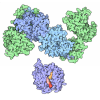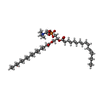+ Open data
Open data
- Basic information
Basic information
| Entry | Database: PDB / ID: 7z51 | ||||||||||||||||||||||||||||||
|---|---|---|---|---|---|---|---|---|---|---|---|---|---|---|---|---|---|---|---|---|---|---|---|---|---|---|---|---|---|---|---|
| Title | Tick-borne encephalitis virus Kuutsalo-14 | ||||||||||||||||||||||||||||||
 Components Components |
| ||||||||||||||||||||||||||||||
 Keywords Keywords | VIRUS / virion / membrane protein / glycoprotein | ||||||||||||||||||||||||||||||
| Function / homology |  Function and homology information Function and homology informationflavivirin / symbiont-mediated suppression of host JAK-STAT cascade via inhibition of STAT2 activity / symbiont-mediated suppression of host JAK-STAT cascade via inhibition of STAT1 activity / viral capsid / double-stranded RNA binding / nucleoside-triphosphate phosphatase / clathrin-dependent endocytosis of virus by host cell / mRNA (guanine-N7)-methyltransferase / methyltransferase cap1 / methyltransferase cap1 activity ...flavivirin / symbiont-mediated suppression of host JAK-STAT cascade via inhibition of STAT2 activity / symbiont-mediated suppression of host JAK-STAT cascade via inhibition of STAT1 activity / viral capsid / double-stranded RNA binding / nucleoside-triphosphate phosphatase / clathrin-dependent endocytosis of virus by host cell / mRNA (guanine-N7)-methyltransferase / methyltransferase cap1 / methyltransferase cap1 activity / mRNA 5'-cap (guanine-N7-)-methyltransferase activity / RNA helicase activity / protein dimerization activity / symbiont-mediated suppression of host innate immune response / host cell perinuclear region of cytoplasm / host cell endoplasmic reticulum membrane / RNA helicase / symbiont-mediated suppression of host type I interferon-mediated signaling pathway / symbiont-mediated activation of host autophagy / serine-type endopeptidase activity / RNA-directed RNA polymerase / viral RNA genome replication / RNA-directed RNA polymerase activity / fusion of virus membrane with host endosome membrane / viral envelope / virion attachment to host cell / host cell nucleus / virion membrane / structural molecule activity / ATP hydrolysis activity / proteolysis / extracellular region / ATP binding / metal ion binding / membrane Similarity search - Function | ||||||||||||||||||||||||||||||
| Biological species |  Tick-borne encephalitis virus Tick-borne encephalitis virus | ||||||||||||||||||||||||||||||
| Method | ELECTRON MICROSCOPY / single particle reconstruction / cryo EM / Resolution: 3.3 Å | ||||||||||||||||||||||||||||||
 Authors Authors | Pulkkinen, L.I.A. / Barrass, S.V. / Anastasina, M. / Butcher, S.J. | ||||||||||||||||||||||||||||||
| Funding support |  Finland, European Union, Finland, European Union,  Sweden, 9items Sweden, 9items
| ||||||||||||||||||||||||||||||
 Citation Citation |  Journal: Viruses / Year: 2022 Journal: Viruses / Year: 2022Title: Molecular Organisation of Tick-Borne Encephalitis Virus. Authors: Lauri I A Pulkkinen / Sarah V Barrass / Aušra Domanska / Anna K Överby / Maria Anastasina / Sarah J Butcher /   Abstract: Tick-borne encephalitis virus (TBEV) is a pathogenic, enveloped, positive-stranded RNA virus in the family . Structural studies of flavivirus virions have primarily focused on mosquito-borne species, ...Tick-borne encephalitis virus (TBEV) is a pathogenic, enveloped, positive-stranded RNA virus in the family . Structural studies of flavivirus virions have primarily focused on mosquito-borne species, with only one cryo-electron microscopy (cryo-EM) structure of a tick-borne species published. Here, we present a 3.3 Å cryo-EM structure of the TBEV virion of the Kuutsalo-14 isolate, confirming the overall organisation of the virus. We observe conformational switching of the peripheral and transmembrane helices of M protein, which can explain the quasi-equivalent packing of the viral proteins and highlights their importance in stabilising membrane protein arrangement in the virion. The residues responsible for M protein interactions are highly conserved in TBEV but not in the structurally studied Hypr strain, nor in mosquito-borne flaviviruses. These interactions may compensate for the lower number of hydrogen bonds between E proteins in TBEV compared to the mosquito-borne flaviviruses. The structure reveals two lipids bound in the E protein which are important for virus assembly. The lipid pockets are comparable to those recently described in mosquito-borne Zika, Spondweni, Dengue, and Usutu viruses. Our results thus advance the understanding of tick-borne flavivirus architecture and virion-stabilising interactions. | ||||||||||||||||||||||||||||||
| History |
|
- Structure visualization
Structure visualization
| Structure viewer | Molecule:  Molmil Molmil Jmol/JSmol Jmol/JSmol |
|---|
- Downloads & links
Downloads & links
- Download
Download
| PDBx/mmCIF format |  7z51.cif.gz 7z51.cif.gz | 299.5 KB | Display |  PDBx/mmCIF format PDBx/mmCIF format |
|---|---|---|---|---|
| PDB format |  pdb7z51.ent.gz pdb7z51.ent.gz | 244.5 KB | Display |  PDB format PDB format |
| PDBx/mmJSON format |  7z51.json.gz 7z51.json.gz | Tree view |  PDBx/mmJSON format PDBx/mmJSON format | |
| Others |  Other downloads Other downloads |
-Validation report
| Summary document |  7z51_validation.pdf.gz 7z51_validation.pdf.gz | 1.9 MB | Display |  wwPDB validaton report wwPDB validaton report |
|---|---|---|---|---|
| Full document |  7z51_full_validation.pdf.gz 7z51_full_validation.pdf.gz | 1.9 MB | Display | |
| Data in XML |  7z51_validation.xml.gz 7z51_validation.xml.gz | 74.2 KB | Display | |
| Data in CIF |  7z51_validation.cif.gz 7z51_validation.cif.gz | 107.8 KB | Display | |
| Arichive directory |  https://data.pdbj.org/pub/pdb/validation_reports/z5/7z51 https://data.pdbj.org/pub/pdb/validation_reports/z5/7z51 ftp://data.pdbj.org/pub/pdb/validation_reports/z5/7z51 ftp://data.pdbj.org/pub/pdb/validation_reports/z5/7z51 | HTTPS FTP |
-Related structure data
| Related structure data |  14512MC M: map data used to model this data C: citing same article ( |
|---|---|
| Similar structure data | Similarity search - Function & homology  F&H Search F&H Search |
| EM raw data |  EMPIAR-11014 (Title: Single-particle reconstruction of Tick-borne encephalitis virus (Final reconstruction) EMPIAR-11014 (Title: Single-particle reconstruction of Tick-borne encephalitis virus (Final reconstruction)Data size: 16.4 TB Data #1: Preparation 2 unaligned movies [micrographs - multiframe] Data #2: Preparation 3 unaligned movies [micrographs - multiframe]) |
- Links
Links
- Assembly
Assembly
| Deposited unit | 
|
|---|---|
| 1 | x 60
|
| 2 |
|
| 3 | x 5
|
| 4 | x 6
|
- Components
Components
| #1: Protein | Mass: 53558.270 Da / Num. of mol.: 3 Source method: isolated from a genetically manipulated source Source: (gene. exp.)  Tick-borne encephalitis virus (WESTERN SUBTYPE) Tick-borne encephalitis virus (WESTERN SUBTYPE)Strain: Neudoerfl / Cell line: SK-N-SH / Production host:  Homo sapiens (human) / References: UniProt: P14336 Homo sapiens (human) / References: UniProt: P14336#2: Protein | Mass: 8311.854 Da / Num. of mol.: 3 Source method: isolated from a genetically manipulated source Source: (gene. exp.)  Tick-borne encephalitis virus (WESTERN SUBTYPE) Tick-borne encephalitis virus (WESTERN SUBTYPE)Strain: Neudoerfl / Cell line: SK-N-SH / Production host:  Homo sapiens (human) / References: UniProt: P14336 Homo sapiens (human) / References: UniProt: P14336#3: Polysaccharide | Source method: isolated from a genetically manipulated source #4: Chemical | ChemComp-CPL / Has ligand of interest | N | Has protein modification | Y | |
|---|
-Experimental details
-Experiment
| Experiment | Method: ELECTRON MICROSCOPY |
|---|---|
| EM experiment | Aggregation state: PARTICLE / 3D reconstruction method: single particle reconstruction |
- Sample preparation
Sample preparation
| Component | Name: Tick-borne encephalitis virus / Type: VIRUS Details: Virus was produced in SK-N-SH cells, purified, and inactivated with UV-C. Entity ID: #1-#2 / Source: NATURAL |
|---|---|
| Molecular weight | Experimental value: NO |
| Source (natural) | Organism:  Tick-borne encephalitis virus / Strain: Neudoerfl Tick-borne encephalitis virus / Strain: Neudoerfl |
| Details of virus | Empty: NO / Enveloped: YES / Isolate: SPECIES / Type: VIRION |
| Natural host | Organism: Homo sapiens |
| Buffer solution | pH: 8.5 |
| Specimen | Embedding applied: NO / Shadowing applied: NO / Staining applied: NO / Vitrification applied: YES |
| Vitrification | Cryogen name: ETHANE |
- Electron microscopy imaging
Electron microscopy imaging
| Experimental equipment |  Model: Titan Krios / Image courtesy: FEI Company |
|---|---|
| Microscopy | Model: TFS KRIOS |
| Electron gun | Electron source:  FIELD EMISSION GUN / Accelerating voltage: 300 kV / Illumination mode: FLOOD BEAM FIELD EMISSION GUN / Accelerating voltage: 300 kV / Illumination mode: FLOOD BEAM |
| Electron lens | Mode: BRIGHT FIELD / Nominal magnification: 81000 X / Nominal defocus max: 2700 nm / Nominal defocus min: 700 nm |
| Image recording | Electron dose: 40 e/Å2 / Film or detector model: GATAN K3 (6k x 4k) |
- Processing
Processing
| CTF correction | Type: PHASE FLIPPING AND AMPLITUDE CORRECTION |
|---|---|
| Particle selection | Num. of particles selected: 642026 |
| Symmetry | Point symmetry: I (icosahedral) |
| 3D reconstruction | Resolution: 3.3 Å / Resolution method: FSC 0.143 CUT-OFF / Num. of particles: 119210 / Symmetry type: POINT |
 Movie
Movie Controller
Controller




 PDBj
PDBj




